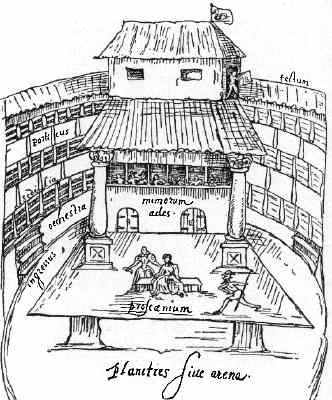The Swan
Click on sections of the illustration to learn about the different parts of the theater.
This sketch of the Swan is the most complete we have of any theater of the time. The Swan was built in 1596; Shakespeare's company, the Chamberlain's Men, played there in the same year.
Footnotes
-
The sketch of the Swan theater
In about 1596, Johannes De Witt visited London; later he wrote about his visit and attached a sketch of the Swan, which he had visited. The original was lost, but a friend (fortunately) had copied it.
De Witt wrote that the theatre could seat 3,000 spectators, and he admired the way the wooden pillars resembled marble.
Click for a more schematic representation of an Elizabethan theater.
-
Flag
The flag was flown on days when there was to be a play.
-
Trumpet
The trumpet sounded three times before the performance began.
-
Roof
- Tectum:
- the roof of the theater.
De Witt does not say whether the Swan's roof was thatched or tiled. The roof of the first Globe was certainly thatched; it caught fire in 1613.
-
Porticus
- Porticus
- covered galleries.
-
Sedilia
- Sedilia
- seats.
-
The Expensive Seats
The orchestra indicated superior seating, probably what were known as the "gentlemen's rooms." Note that they are close to the stage, at what we think of as the side, rather than directly in front.
-
Ingressus
- Ingressus
- the entry.
-
Proscaenium
The proscaenium, or platform, is the actual playing area. It was large—it projected half way into the "yard" where the lowest-paying customers, the "groundlings," stood. Note that the only stage property in the scene represented is a bench.
-
Arena
Arena: The yard; the area where the "groundlings" stood through the performance.
-
Back stage
The mimorum aedes, "tiring [attiring] house," was the backstage, where actors dressed, and from which they entered the stage.
The two doors allowed flexible movement on and off the stage, so that scenes could flow rapidly.
-
The Lord's Room?
In this sketch some spectators are behind the stage, the highest paying customers, in what was probably the "Lords' room." The central area "above" must also have been used for such scenes as the balcony scene in Romeo and Juliet, and a city's walls in many scenes in the History plays.
-
The heavens
The roof above the stage was called the "heavens," and a throne could be let down from it by pulley.
